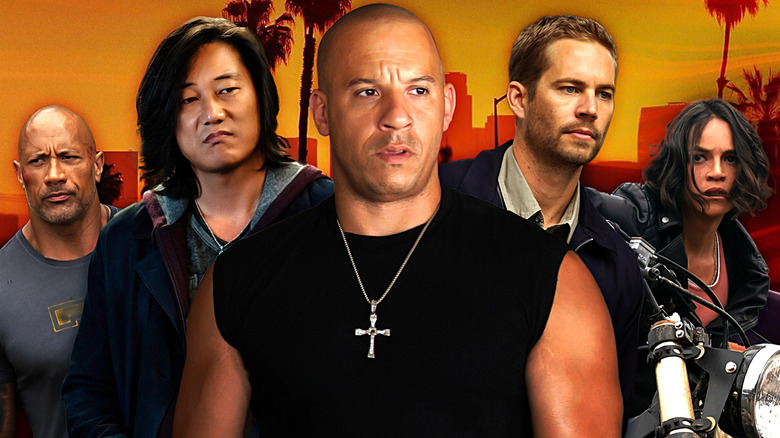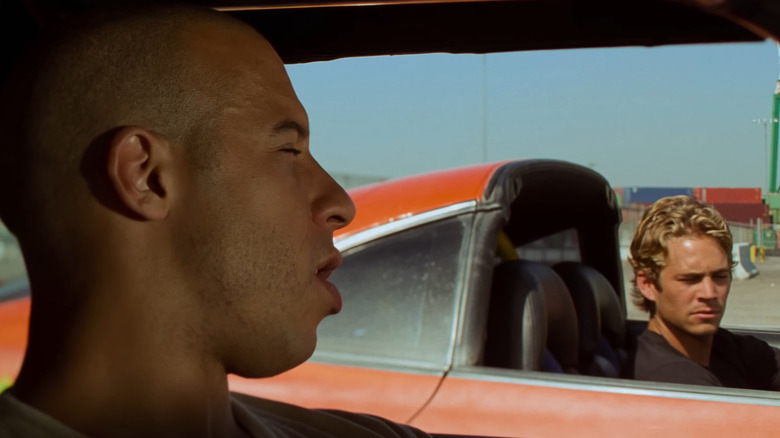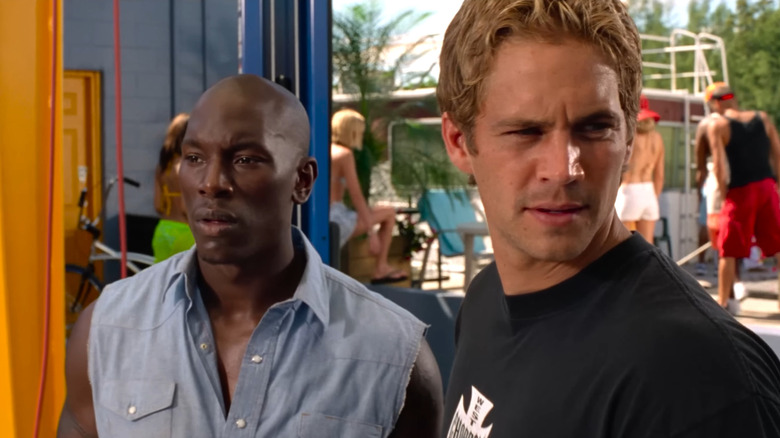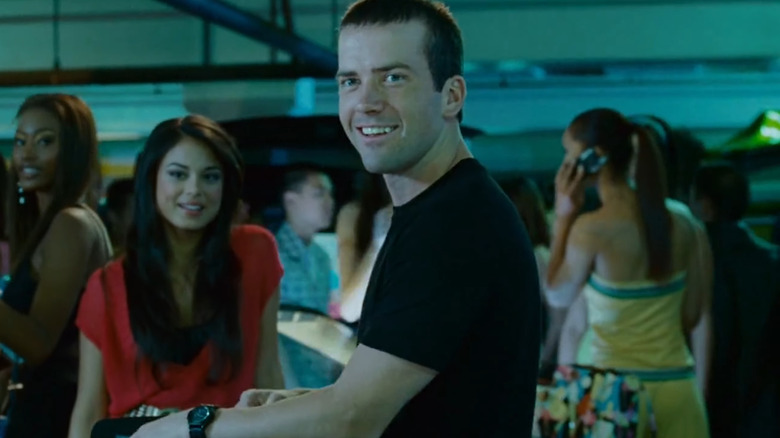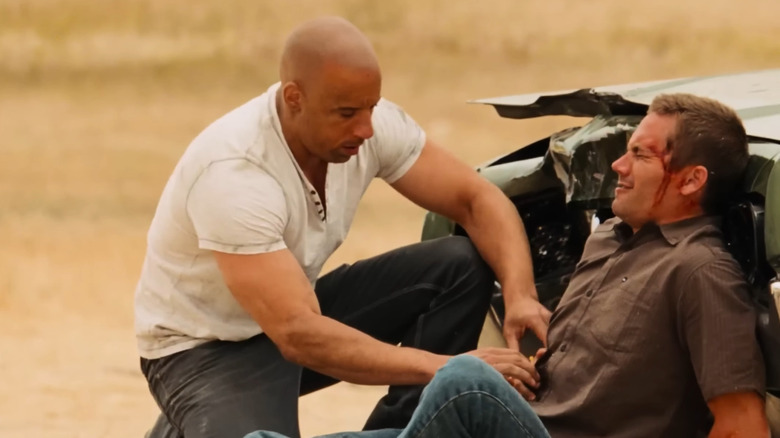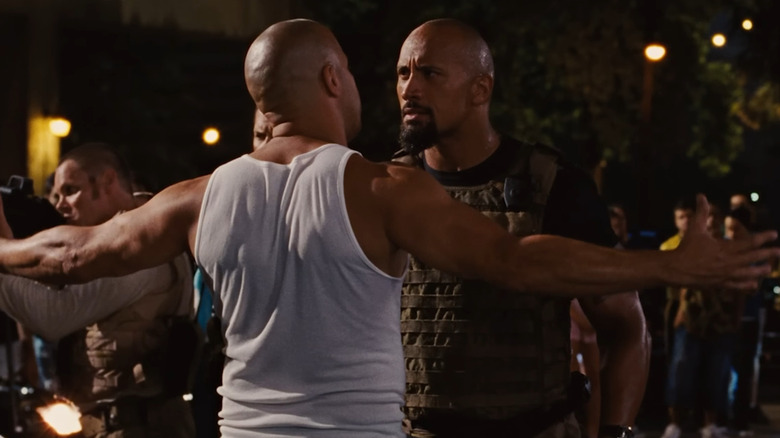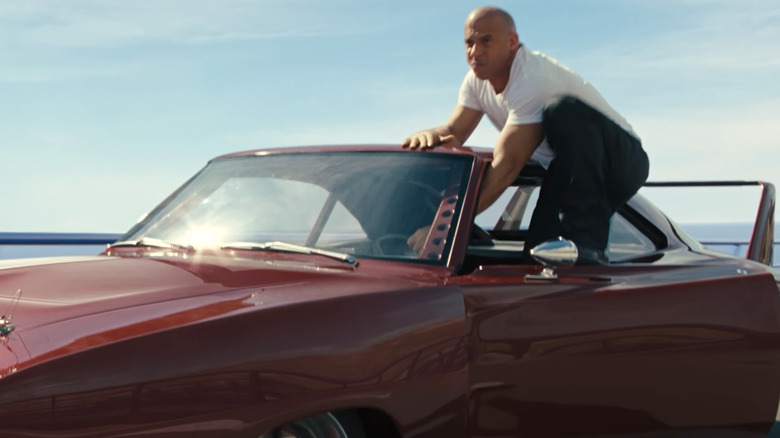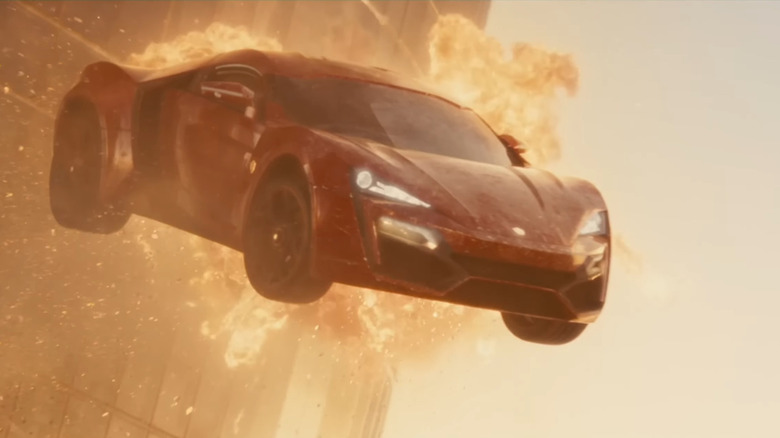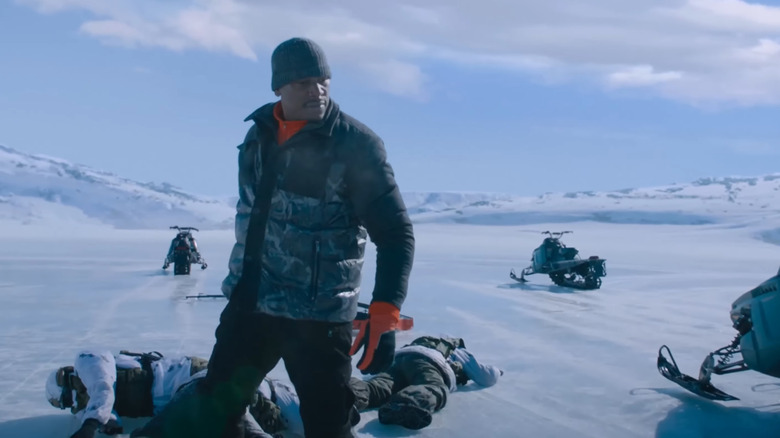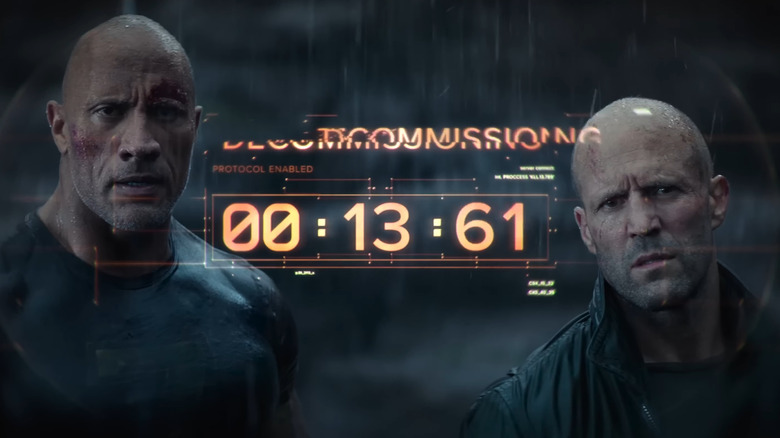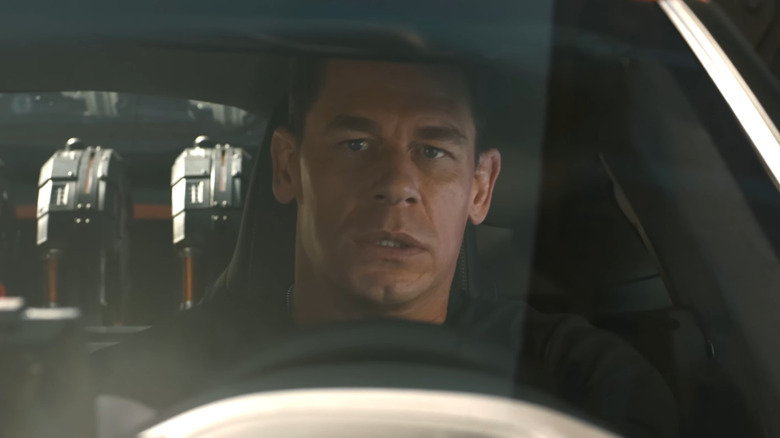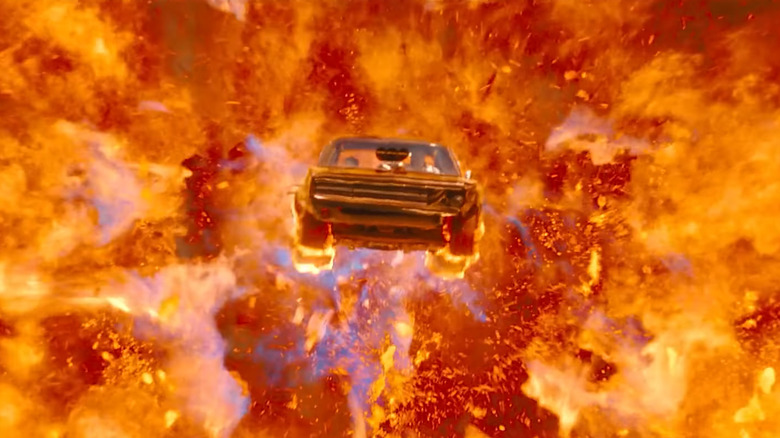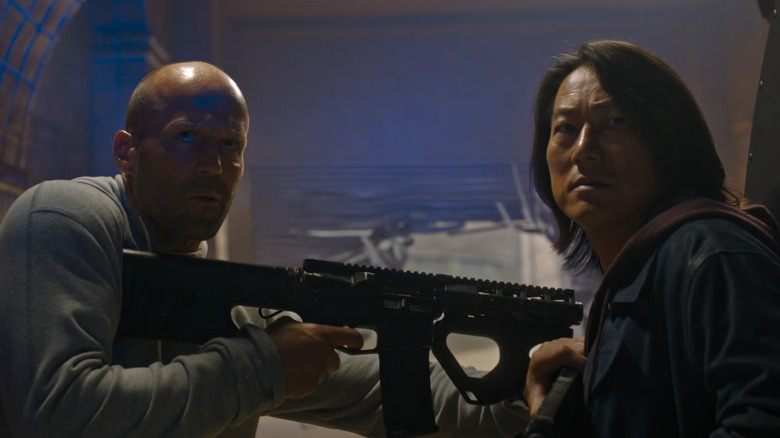How To Watch The Fast And Furious Movies In Order
When it comes to the "Fast & Furious" franchise, real fans know it isn't about the cars, the money, the action, or the story — it's about family. But, y'know, also all those other things too. In fact, "Fast & Furious" is so concerned with its overarching narrative that it haphazardly constructed a twisted timeline that's hard for newcomers to process. Starting in 2001, the films were released in this order:
-
"The Fast and the Furious"
-
"2 Fast 2 Furious"
-
"The Fast and the Furious: Tokyo Drift"
-
"Fast & Furious"
-
"Fast Five"
-
"Fast and Furious 6"
-
"Furious 7"
-
"The Fate of the Furious"
-
"Fast and Furious Presents: Hobbs & Shaw"
-
"F9"
-
"Fast X"
The "Fast & Furious" movies can absolutely be watched, understood, and enjoyed in this order if the viewer relents to the franchise's reckless pace and internal logic. Having said that, there is an alternate viewing order we'll discuss later that could improve a newcomer's appreciation for these ridiculously awesome films.
The Fast and the Furious
For the uninitiated (or for those who hopped into the film series with its soft reboot in 2009), the first movie in the franchise, "The Fast and the Furious," is sleeker and simpler in just about every way than any entry that comes after. By all accounts, the 2001 feature wasn't produced as the jumping off point for a major studio property. To Vin Diesel, it was an epic crime drama meant to stand on its own, requiring intense, method, and potentially illegal preparation and filmmaking that followed in the footsteps of great artists like Francis Ford Coppola; to everyone else involved, it was basically "Point Break" with race cars. This is all to say, "The Fast and the Furious" is as self-contained and sensible as these movies get. It was directed by Rob Cohen (who would go on to make "xXx" with Diesel immediately afterward) and written by Gary Scott Thompson, Erik Bergquist, and David Ayer, none of whom would continue to be involved with the film series.
For the purposes of the overarching narrative, "The Fast and the Furious" mostly serves to introduce audiences to the core cast of heroes they'll be following for the next nine mainline movies. At the center of the action is Brian O'Connor (the late Paul Walker), a hotshot Los Angeles Police Department officer tasked with going undercover in the underground world of illegal street racing in order to stop an elite network of criminals who use their driving skills to execute elaborate acts of burglary.
The lead suspect in the LAPD's investigation is Dominic Toretto (Diesel). Hence, Brian must earn Dom's trust and respect, along with the respect of the most important thing in his life — his family. This includes Dom's ride-or-die girlfriend Letty Ortiz (Michelle Rodriguez) and his sister Mia (Jordana Brewster), who may or may not develop feelings for a certain undercover cop. As Brian gets closer to solving his case, his sense of justice, morality, and loyalty are tested, leading to a race that decides the fate of his freedom and his place between two worlds.
2 Fast 2 Furious
We weren't being glib when we said Vin Diesel wanted "The Fast and the Furious" to have the same artistic integrity as the films of Francis Ford Coppola. After the runaway success of the first movie, he was offered millions of dollars to return for a sequel that — from Diesel's perspective — failed to move the story forward in a way that justified its existence. Thus, he turned an attractive, star-making offer down in favor of bolder opportunities, and in a later explanation of his absence from the sequel, 2003's "2 Fast 2 Furious," he specifically name-checked Coppola in his reasoning. Ja Rule, who played a minor part in the first film, also declined to return for "2 Fast 2 Furious" despite being promised a much larger role.
Without Dominic Toretto, director John Singleton and writers Michael Brandt and Derek Haas essentially had to hit the reset button on the story entirely, moving away from Dom's crew and creating a new web of characters around Paul Walker's Brian. As such, Ja Rule's character was replaced by the new race master general Tej Parker, played by fellow rapper Ludacris. His role was significantly larger than Ja Rule's in the first film, too, with Ludacris having since become a core member of the franchise's cast. "2 Fast 2 Furious" also introduces the character Roman Pierce, an ex-convict with personal ties to Brian.
Though they are both given another deep cover storyline that creates similar but novel enough tension compared to "The Fast and the Furious," Brian and Roman's shared history moves the property into a more lighthearted, bantery, buddy cop territory that would become part of its identity in later films. The story picks up in the aftermath of "The Fast and the Furious," with Brian having parted ways with the LAPD. He's then given a shot at redemption by his old colleagues, who need his help to take down a drug lord in Miami, Florida.
The Fast and the Furious: Tokyo Drift
Despite introducing fan favorite characters Tej and Roman and giving Paul Walker's Brian more focus, "2 Fast 2 Furious" didn't do much for fans of the first film and is now remembered as both the definitive low point of the property's early days and one of the worst entries in the "Fast & Furious" franchise overall. To make matters worse for Universal, it was in its weakest position yet casting wise going into development on another sequel. Even if Vin Diesel had loved "2 Fast," he had already found other opportunities that were occupying the bulk of his time — though he agreed to be involved in a then-superficial-but-eventually-very-meaningful capacity in exchange for the rights to his character Riddick from "Pitch Black." Walker, meanwhile, was completely uninterested in returning for another "Fast" film and declined to be involved whatsoever.
Thus, Universal once again wanted to hit the reset button and searched for a fresh story (from writer Chris Morgan and director Justin Lin) that could focus on different characters in an entirely new environment. Hoping to appeal to younger audiences, the studio cast "Jarhead" actor Lucas Black as high school student Sean Boswell, who is sent to live with his estranged father in Tokyo, Japan, after an incident involving illegal street racing. While abroad, Sean faces severe culture shocks, bullying, and — somewhat inexplicably — multiple run-ins with the Yakuza crime syndicate.
He is only able to survive by befriending fellow American Twinkie (played by rapper Bow Wow) and veteran street racer Han Lue. Played by Sung Kang, Han was originally created by Lin for his short film "Better Luck Tomorrow." Once Lin became a key part of the "Fast" creative DNA, so did Han and Kang — which, without spoiling anything, created one of the wildest cinematic timelines ever. For now, we'll just say that "Tokyo Drift" is another self-contained story that might well be the "Fast" franchise at its best.
Fast & Furious
Contemporary praise for "Tokyo Drift" aside, it wasn't well-received at the time of its release in 2006 — save for some hype surrounding Vin Diesel's attachment to the film. Again, without spoiling anything, it may be one of the earliest instances of a now-common phenomenon in franchise filmmaking, in which stars are able to will an entire project into existence just by publicly flirting with the idea of returning to a property.
This was seemingly the case when, in the years leading up to its release in 2009, Universal began working on another reset of the "Fast" universe that would bring back Diesel, Paul Walker, Michelle Rodriguez, and Jordana Brewster, as well as Justin Lin, Chris Morgan, and Sung Kang from the previous film. Presumably in order to give themselves as much narrative freedom as possible — and to create the most potential for new audiences to be attracted to the project — the fourth movie would be set before "Tokyo Drift" chronologically and would even avoid any mention of it being the fourth entry in marketing. It would simply be titled "Fast & Furious."
The studio also released a short film titled "Los Bandoleros" that helps establish the plot and characters for newcomers and teases what has happened since the original film for returning fans. "Fast & Furious" itself follows Brian — now an agent of the FBI — as his search for a Mexican drug lord leads him back into the world of Dom and his crew. Besides establishing a clean slate for the franchise, the film is also notable for introducing Gal Gadot's femme fatale, Gisele Yashar.
Fast Five
While "Fast & Furious" reworked the property's formula explicitly to launch a franchise from the safest lane possible, "Fast Five" drives the "Fast" universe in almost every way. Vin Diesel, Paul Walker, and Jordana Brewster all return from "Fast & Furious," with the story picking up right after the final scene of the previous film. The central plot kicks off with Brian being forced to go on the run with Dom and his crew when another drug lord frames them for killing agents from the DEA.
"Fast Five" is notable for starting to fold in characters from across the "Fast" universe into the core cast, beginning with Sung Kang (who returns properly as Han after mostly cameoing in "Fast & Furious") and Gal Gadot, now playing Gisele as a member of Dom's crew. Tyrese Gibson and Ludacris are also both brought back from "2 Fast 2 Furious" to serve on Dom's crew, their characters slightly reworked in both characterization and individual skill sets to fit into the new, supercharged "Fast" storyline. Arguably, though, the biggest casting choice (literally and figuratively speaking) made for the film was the hiring of Dwayne Johnson as Diplomatic Security Service Agent Luke Hobbs, who serves as the film's major antagonist throughout. Johnson and Hobbs would go on to become key (and volatile) players in the "Fast" franchise. Elsa Pataky also debuts in this film as Hobbs' team member, Elena Neves
"Fast Five" is, ultimately, when the films really shift into gear as the movies we know today — from a lean film series about racing and robbing to a blockbuster franchise about spies, cutting edge tech, and ridiculous stunts. It was also a massive box office hit and remains in conversation as not only the (potential) best "Fast" movie but also one of the greatest action movies of all time.
Fast and Furious 6
From here on, it gets a bit harder to describe these movies without spilling any spoilers on the road. Don't worry, no spoilers lie ahead — just forgive us if we have to talk less about things like plot and character and more about the smashy smashy car chases (which, funnily enough, is a dynamic the movies themselves adopt around this point as well).
Coming off the success of "Fast Five," the fourth straight "Fast" film from Justin Lin and Chris Morgan is something of a victory lap for the property. Even so, it has one of the best action scenes in the franchise, while secondary characters like Han, Gisele, Hobbs, and Elena are given chances to develop into more compelling figures.
Apart from that — and one major twist in what quickly becomes a sprawling, soap-opera-like overarching story-web for the franchise — "Fast and Furious 6" establishes the middle ground for the "Fast" franchise. Not as boring as "2 Fast 2 Furious," not as triumphant as "Fast Five," but a good-enough film that shifts almost immediately into cruise control — at least, until the film's final moments, which jaw-droppingly tie its events back to "Tokyo Drift," bringing the movie's continuity to the present-day and introducing another major character in the franchise moving forward.
Furious 7
"Furious 7" is a masterpiece of retroactive storytelling, in part for deeply tragic reasons. As readers might be aware, Brian O'Connor actor Paul Walker died in a car accident during production, compelling writer Chris Morgan and newcomer director James Wan to rework the film's ending to resolve Brian's character arc.
At the same time, before Walker's death, Morgan specifically had the task of finally unwinding the franchise's messy timeline to make sense of the "Tokyo Drift" time-jump (revisiting an earlier, unresolved scene from the then-nine-year-old film) and introduce (properly) Jason Statham's villainous Deckard Shaw (the vengeful brother of the villain from the previous film). "Furious 7" also makes several additions to the ever-growing "Fast" ensemble, including Nathalie Emmanuel as the hacker Ramsey and Kurt Russell as Mr. Nobody, the director of a clandestine military organization. The plot sees Dom's crew attempt to track down a dangerous piece of technology while outrunning a new threat born of their last mission.
The Fate of the Furious
Maybe it's because "Furious 7" ends with such cathartic finality, but "The Fate of the Furious" just can't create enough realistic, compelling forward momentum to justify the continuation of the property. Chris Morgan returns once more to pen the script (with newcomer F. Gary Gray stepping into the driver's seat as director), which valiantly tries to upset the "Fast" formula by forcing the team to face off against Dom in the most convoluted way possible.
Could this be because it was 2017, and "Captain America: Civil War" and "Batman v. Superman" had thrown Hollywood into a good-guys-fighting-each-other phase? Or because Vin Diesel and now-top-billing-co-star Dwayne Johnson were feuding so hard they couldn't shoot scenes together? Either way, this forced plot is so reliant on twists that we won't say too much about it here. What we can say about its impact on the franchise moving forward is that "Fate" introduces Charlize Theron's Cipher and sets up the property's first true spin-off film.
Fast and Furious Presents: Hobbs and Shaw
In terms of the overarching "Fast" story, "Hobbs and Shaw" is mostly irrelevant ... but it's also mostly fun enough to watch anyway. Dwayne Johnson takes command of the franchise alongside Jason Statham as they co-lead a buddy movie about a by-the-book (ex-)government agent teaming up with an international criminal mastermind to take down a super soldier (played by Idris Elba, who is clearly having the most fun on set).
Chris Morgan, co-writer Drew Pearce ("Iron Man 3," "Mission: Impossible — Rogue Nation"), and director David Leitch tell a self-contained story that uses just enough "Fast" mythos to connect it to the franchise but is largely an unrelated sci-fi action-comedy that exists at the furthest extreme of what a "Fast" movie can be, logically speaking. That said, if Johnson's announced "Hobbs" film materializes, "Hobbs and Shaw" may be made more important to the overall "Fast" narrative retroactively.
F9
With Dwayne Johnson busy carving out his own corner of the "Fast" universe (as well as his own corner of the DC Extended Universe via the ill-fated "Black Adam"), the ninth mainline "Fast and Furious" film needed a new, eye-catching WWE star for their cast. Naturally, it enlisted John Cena's help.
As is revealed in the movie's trailers, Cena plays Jakob Toretto, the long-lost brother of Vin Diesel's Dom Toretto who was cast out from the Toretto family for ... reasons. But now he's back as a deadly double agent working for Charlize Theron's Cipher in order to get revenge on Dom. Despite all this implied drama, "F9" is mostly more wheel-spinning as the franchise tries to decide where it's headed — though returning director and co-writer Justin Lin does bring back a key character you likely never expected to see again.
Fast X
Last, and by some standards least, we have the 10th mainline "Fast" film "Fast X," which openly aspires to be the "Avengers: Infinity War" of this now-overblown franchise. As of writing, there's no firm update yet on when the "Endgame" will finally come about.
We really can't say much about "Fast X" without spoiling it or the 10 films it draws from for its overwrought plot. Suffice it to say, basically anyone and everyone who's ever been in a "Fast" movie returns to stop the vengeful machinations of Jason Momoa's Dante, another villain retconned into the crew's past, who arms himself with a powerful weapon, also from their past. This film is now confirmed to be the second-to-last entry, at least in the main fast storyline and potentially even the franchise overall (depending on the status of that "Hobbs" film). Fair warning, it's very much a "Part One" movie, if you catch our drift...
Fast and Furious: Chronological Order
The "Fast & Furious" film series is one of the rare blockbuster franchises with a wonky timeline that actually works better if you watch the films chronologically. Without spoiling anything, the way the films are plotted, there's no real reward to jumping straight from "2 Fast 2 Furious" to "Tokyo Drift." On the other hand, if you follow up "2 Fast" with 2009's "Fast & Furious," you get to continue following plot threads from the prior two films. In chronological order, your "Fast" marathon should go like this:
-
"The Fast and the Furious"
-
"2 Fast 2 Furious"
-
"Fast & Furious" (2009)
-
"Fast Five"
-
"Fast and Furious 6"*
-
"The Fast and the Furious: Tokyo Drift"
-
"Furious 7"
-
"The Fate of the Furious"
-
"F9"
-
"Fast and Furious Presents: Hobbs and Shaw"**
-
"Fast X"
*Regarding "Fast and Furious 6," readers should be aware of a spoiler for "Tokyo Drift" in the film's post-credits scene. That said, it also functions as a thrilling and strangely natural lead-in for said film, so use your own discretion as to whether you watch the scene before or after watching all of "Tokyo Drift."
**As for "Hobbs and Shaw," this can be watched any time after "Fate." We feel it's most satisfying to stay with Dom and his crew through "F9," then take a brief detour for the spin-off so you have a sense of where all the major players are headed into the absurd, climactic "Fast X."
